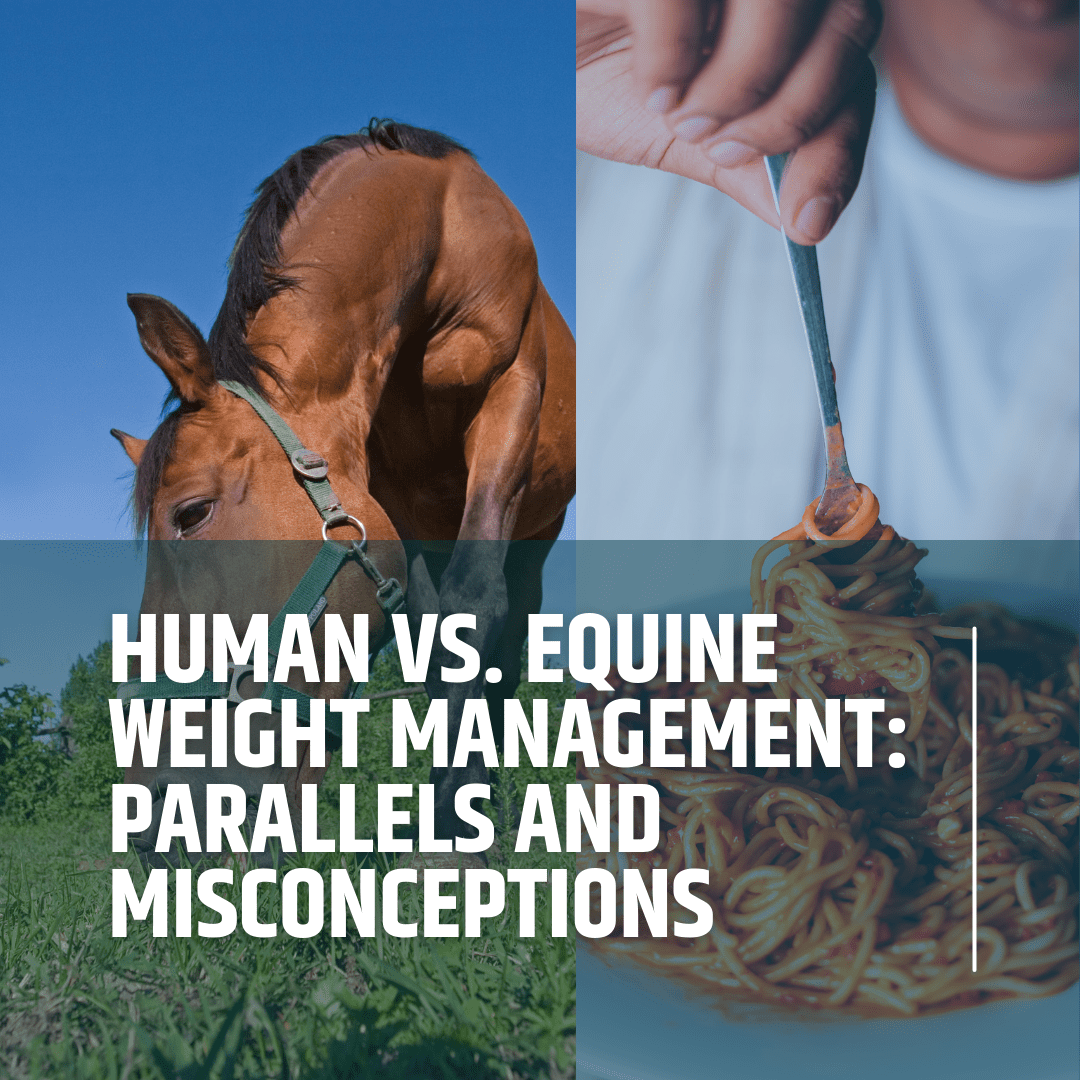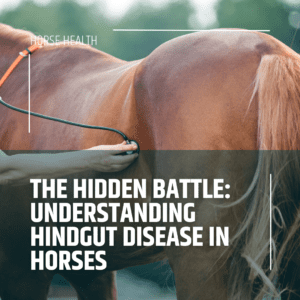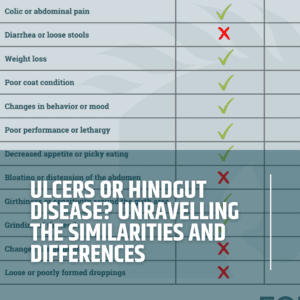
01
Introduction
Weight management is a complex issue that affects both humans and animals. Although vastly different in their physiological makeup and environmental needs, humans and horses share intriguing parallels when it comes to weight management. Their metabolic processes, susceptibility to environmental and dietary changes, and the impact of activity levels on their overall health create remarkable points of comparison. Both species are often subject to misconceptions surrounding feeding practices, with misunderstandings in dietary needs leading to health complications. This article explores the shared principles of weight management in humans and horses, highlighting the similarities and pitfalls that exist in managing diet and metabolism for optimal health.
02
Metabolic Parallels: Human and Horse Physiology
At the core of both human and equine weight management lies the metabolism, the biological process by which the body converts food into energy (2). Both humans and horses have evolved systems that adapt to environmental changes, activity levels, and caloric intake (3). Understanding these processes offers insights into how weight gain or loss can occur, and it underscores the importance of appropriate feeding and exercise strategies.
Horses, being herbivores, have a highly specialised and complex digestive system designed to process fibrous plant materials (4). According to the British Horse Society, their gastrointestinal system is built for near-constant grazing, which provides a steady stream of fibre that fuels their metabolism (4). The microbial fermentation process in their hindgut breaks down fibre, producing energy and other essential nutrients (4). In contrast, humans have an omnivorous diet, requiring a balance of carbohydrates, proteins, and fats to sustain their metabolic needs (5). While humans do not depend on microbial fermentation to the same degree, the gut microbiome still plays a significant role in processing food and maintaining metabolic health (5).
Despite these differences, both humans and horses are affected by calorie intake and expenditure. Excessive caloric intake without sufficient physical activity leads to weight gain, while caloric restriction or increased physical exertion results in weight loss (2). Additionally, both species experience seasonal variations in metabolism (2). According to Johnson et al. (2009), winter months often bring a slower metabolism to horses due to reduced activity and colder temperatures, much like the human tendency to gain weight during the colder seasons when physical activity may decrease and caloric intake may increase (2). However, Kentucky Equine Research offers a different perspective, noting that horses tend to lose weight during winter because they burn more calories to stay warm (11). In colder months, their bodies must generate more heat, which increases their energy requirements (11). If they don't consume enough calories to meet this demand, they start using stored fat as fuel, leading to weight loss. Additionally, during winter, pasture availability may be limited, reducing their access to nutrient-rich forage (11). The combination of increased caloric needs and reduced food availability often causes horses to lose weight in the winter (11).
These shared patterns reveal that weight management in both humans and horses is heavily influenced by environmental conditions, diet, and activity levels.
03
Calorie Intake: Human and Horse Requirements
Caloric intake is a critical factor in weight management, and understanding the average requirements for humans and horses can help clarify how diet plays a role in maintaining or altering body weight. In the UK and many other countries, energy requirements are often expressed in MegaJoules (MJ). For comparison, we'll also provide the equivalent in megacalories (Mcal), which are commonly used in some regions. One MegaJoule (MJ) is equivalent to approximately 0.239 Mcal.
As mentioned earlier, the average daily caloric requirement for humans varies based on factors such as age, gender, and activity level. According to the NHS, an adult woman typically needs around 8.4 MJ (2,000 kilocalories or kcal) per day, while an adult man requires approximately 10.5 MJ (2,500 kcal) (6). This amount can increase for more active individuals or decrease for those with a more sedentary lifestyle.
In contrast, horses have much higher energy needs. The average adult horse, depending on its size and activity level, generally requires between 63 and 126 MJ (15 and 30 Mcal) of digestible energy (DE) per day (1). Here’s an example of horse daily energy requirements according to the American Veterinary Medical Association (1) :

It’s important for horse owners to adjust the diet based on the horse’s workload, size, and body condition, ensuring that the right balance of forage, grains, and other feed types is maintained to meet these energy needs without leading to excessive weight gain or health problems.
By understanding the terminology and energy requirements in both human and equine nutrition, it becomes easier to draw meaningful comparisons and avoid the common pitfalls of over- or underfeeding.
04
Diet and Activity: Balancing Inputs and Outputs
The relationship between diet and activity is a crucial aspect of weight management in both humans and horses. Both species require a careful balance between caloric intake and energy expenditure to maintain a healthy weight. However, this balance is often disrupted by modern feeding practices and lifestyle changes, which can lead to metabolic disorders and obesity (7).
For humans, modern diets are typically high in processed foods and refined sugars, which contribute to an excess of calories and a surge in obesity rates. The sedentary nature of many contemporary lifestyles exacerbates this problem. Regular physical activity is essential for maintaining a healthy metabolism, yet many individuals fail to meet the recommended levels of exercise. When caloric intake consistently exceeds energy expenditure, the body stores the excess energy as fat, leading to weight gain.
Similarly, horses can suffer from weight-related issues when their diet is not aligned with their activity levels. Horses that are kept in stables with limited turnout or exercise often do not release enough energy to balance the calories they consume, resulting in weight gain (8). Moreover, some horse owners may overfeed their horses in the mistaken belief that more food equates to better health, failing to recognise that an imbalance between diet and activity can lead to metabolic conditions such as equine metabolic syndrome (EMS) or laminitis (8).
It is worth noting that not all horses or humans will gain weight in the same way, even when subjected to similar conditions. Just as humans may have a predisposition to gain or lose weight due to genetic factors or metabolic rate, horses also display individual variability in their ability to gain or lose weight. Some horses, particularly native breeds such as Shetlands and Welsh ponies, are prone to weight gain and are known as "good doers," meaning they can maintain weight on relatively low-quality forage (9). Similarly, some humans possess a slower metabolism, making it more difficult for them to lose weight even when engaging in regular physical activity.
05
Misconceptions in Feeding: Human and Equine Perspectives
Feeding practices are another area where parallels can be drawn between humans and horses. In both cases, misconceptions about dietary needs abound, often leading to health complications.
Many people struggle to understand their own nutritional needs, which has led to a proliferation of fad diets, misinformation, and unhealthy eating habits. For example, the over-restriction of calories or entire food groups, such as carbohydrates, can result in nutritional deficiencies and metabolic imbalances. On the other hand, excessive consumption of highly processed foods, laden with sugar and unhealthy fats, contributes to obesity and associated health problems. These misunderstandings are often driven by conflicting information about what constitutes a healthy diet.
Similarly, horse owners frequently misjudge the nutritional needs of their horses. One common mistake is overfeeding grain or concentrate feed, which is often unnecessary for horses that are not in hard work. Horses evolved to thrive on a forage-based diet, with their energy coming predominantly from fibrous plant material. Feeding them too much grain can result in an overload of starch, leading to digestive upset and even serious conditions such as colic or laminitis (10). Additionally, many horse owners fail to adjust their horses' diets based on their activity levels or body condition. Horses that are not in regular work may require significantly fewer calories than those in training or competition, yet owners may continue to feed them the same quantity of food.
Another misconception involves the idea that all horses, regardless of size or workload, require similar amounts of feed. In reality, a horse's diet should be carefully tailored to its size, age, workload, and metabolic rate. Ponies and smaller horses generally require less food than larger breeds, and horses with a tendency to gain weight should be given lower-calorie diets, with their food intake closely monitored (2). Similarly, in humans, portion control and the quality of food consumed are often overlooked, leading to overeating and weight gain.
06
Conclusion
The parallels between human and equine weight management illustrate the importance of understanding both the physiological and environmental factors that influence weight gain and loss. In both species, mismanagement of diet and activity levels can lead to serious health issues, yet simple steps can be taken to prevent these outcomes. Monitoring caloric intake, aligning diet with activity levels, and avoiding common misconceptions about feeding are crucial strategies in maintaining healthy weight and metabolic balance in both humans and horses. Ultimately, whether managing the weight of a horse or a human, a personalised and informed approach is key to achieving long-term health and well-being.
References
[1] American Veterinary Medical Association. (2021, February 1). How to feed an equine athlete.
[2] Johnson, P. J., Wiedmeyer, C. E., Messer, N. T., & Ganjam, V. K. (2009). Medical implications of obesity in horses--lessons for human obesity. Journal of diabetes science and technology, 3(1), 163–174.
[3] Luca, F., Perry, G. H., & Di Rienzo, A. (2010). Evolutionary adaptations to dietary changes. Annual review of nutrition, 30, 291–314.
[4] The British Horse Society. (2024, July 31). The digestive system.
[5] Singh, R. K., Chang, H. W., Yan, D., Lee, K. M., Ucmak, D., Wong, K., Abrouk, M., Farahnik, B., Nakamura, M., Zhu, T. H., Bhutani, T., & Liao, W. (2017). Influence of diet on the gut microbiome and implications for human health. Journal of translational medicine, 15(1), 73.
[6] NHS. (2024). Understanding calories.
[7] Romieu, I., Dossus, L., Barquera, S., Blottière, H. M., Franks, P. W., Gunter, M., Hwalla, N., Hursting, S. D., Leitzmann, M., Margetts, B., Nishida, C., Potischman, N., Seidell, J., Stepien, M., Wang, Y., Westerterp, K., Winichagoon, P., Wiseman, M., Willett, W. C., & IARC working group on Energy Balance and Obesity (2017). Energy balance and obesity: what are the main drivers?. Cancer causes & control : CCC, 28(3), 247–258.
[8] Blue Cross. (2024). Horse obesity prevention and management.
[9] Durham, A. E., Frank, N., McGowan, C. M., Menzies-Gow, N. J., Roelfsema, E., Vervuert, I., Feige, K., & Fey, K. (2019). ECEIM consensus statement on equine metabolic syndrome. Journal of veterinary internal medicine, 33(2), 335–349.
[10] Hughes, C. (2023, September 27). Acidosis laminitis – acidosis, lush grass and laminitis. Improve Veterinary Practice.
[11] Kentucky Equine Research. (2023, April 10). Spring Bulk: Adding Weight to Horses After Winter.
ABOUT EQUINECTAR
Description
EquiNectar® is a natural feed supplement, that is scientifically proven to:
- Re-balance your horse’s gut bacteria
- Help your horse maximise benefits from its feed
- Improve your horse’s condition
More information
EquiNectar® is produced by Tharos Ltd in the UK. It is a natural source of digestive enzymes and contains only the following ingredients:
- Our patented enzyme rich malt extract
- Medium chain triglycerides (from coconut oil)
- Potassium sorbate
For more details of the enzymes within EquiNectar® take a look at the ingredients and enzymes page.
How to feed
Simply add EquiNectar® to your horse's daily feed, using the Feeding Rate chart to determine the correct amount.
For detailed instructions about how to introduce EquiNectar, please read the comprehensive Feeding Guide page.





